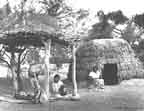Trading Posts
BERT STAPLES
 There was a wonderful man named Berton I.
Staples, who had come west for his health. He had been a
dress-designer in New York. When he came I do not know, but in 1926,
he was well-established. He established a trading post on Highway 66
at Coolidge, New Mexico, which he called Crafts del Navajo.
There was a wonderful man named Berton I.
Staples, who had come west for his health. He had been a
dress-designer in New York. When he came I do not know, but in 1926,
he was well-established. He established a trading post on Highway 66
at Coolidge, New Mexico, which he called Crafts del Navajo.
It is difficult for me to understand the amount of
energy, will-power and intelligence that is necessary for a
dress-designer from New York to establish a trading post in the wild
west. The life was extremely primitive in those days, and it is a
miracle that a human could make this change.
To be a trader in that country meant many things. One
had to be a business man, a psychologist, a sociologist, a carpenter,
an expert horseman, an expert in metal-work, textiles and pottery,
not to mention an art critic. One of the most important things was to
be a politician, with a little anthropology thrown in. It also helped
to be a cook.
Most of the traders were good people, and a few were
bad. Mr. Staples was one of the very good ones. To be a good trader
meant that you paid the Indians equitable prices for their products,
that you did not sell the pawned items if you could help it, even
when it would be legal, that you helped to settle dis¬putes when
it was appropriate, that you cared for those who needed it, and so
on.
Mr. Staples took part in all of the doings around the
country-side. This included the Gallup Ceremonial and later on, the
Indian Arts and Crafts Board. He arranged trips for tourists, and,
indeed, for Mom and Pop.
With their common interest and knowledge of the
Indians and the Indian Problem, Mr. Staples and our parents quite
naturally became very close friends. We always stopped at Coolidge on
the way through.

OLD SILVER
AND NEW SILVER
On one trip to the Southwest, we stopped overnight at Mr.
Staples' place. Mr. Staples and my father got into a discussion. The conversation
turned to the problem of distinguishing between old silver and new, or modern,
silver. Pop was propounding the idea that old silver had a certain aura about
it which differentiated it from modern silver. Mr. Staples disagreed. Finally,
Mr. Staples said to Pop, "Charlie, let me have that bracelet Ruth is wearing.
When you come back on the way home, you can pick it up." So Mom took it off
and handed it over. The next morning we went on our way. On our return we stopped
overnight again at Coolidge. During the evening, Mr. Staples brought out Mom's
bracelet. Only, there were two of them. He handed them to Pop and said, "Which
one is Ruth's?" Pop looked and looked, but he could not tell. Mom couldn't tell.
None of us could tell. They were identical, and, as I remember it, we never
did figure out which was Mom's. One of Mr. Staples' silversmiths had copied
Mom's bracelet and there you are.
 There was a wonderful man named Berton I.
Staples, who had come west for his health. He had been a
dress-designer in New York. When he came I do not know, but in 1926,
he was well-established. He established a trading post on Highway 66
at Coolidge, New Mexico, which he called Crafts del Navajo.
There was a wonderful man named Berton I.
Staples, who had come west for his health. He had been a
dress-designer in New York. When he came I do not know, but in 1926,
he was well-established. He established a trading post on Highway 66
at Coolidge, New Mexico, which he called Crafts del Navajo.